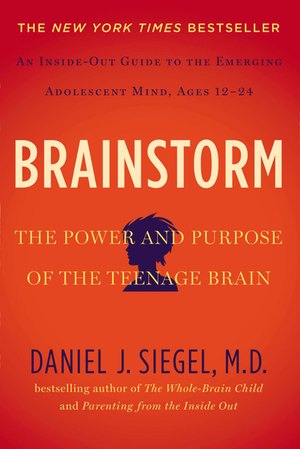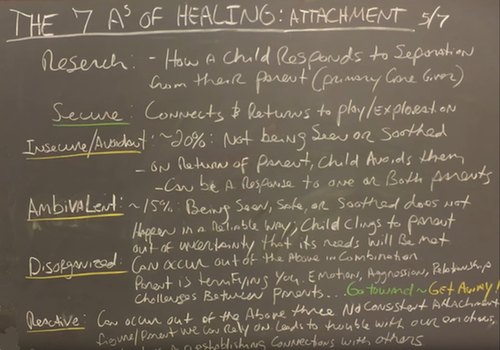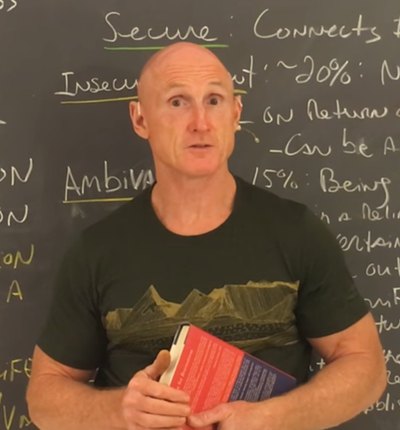The Seven A’s of Healing Part 5: Attachment
Happy Monday again to all of you! WOW, time goes by so fast and it’s only five weeks away until the start of a New Year!
Part 5 of my Seven A’s of Healing is all about attachment, and a brief look at very recent research that’s examined our connections to other people at a very young age.
(Just wanted to remind you that this latest series is based on Dr. Gabor Mate’s awesome book, When The Body Says No: Understanding The Stress-Disease Connection.)
Depending on the study, the parent is separated from their young child (between ages 1-2) who’s left in a room alone for few minutes with toys and other distractions. During that time, scientists will observe how the child reacts to being alone, then how he/she responds when the parent returns.
The research I’ve read about, along with the questionnaires that were used, have been very comprehensive and have yielded some very powerful results.
How that “programming” shapes us early on is critical knowledge that manifests itself for the remainder of our lives. So, why is that important? A lot of disease stems from the exhaustion of our ability to cope with our programming and the challenges often produced in relationship to the self or others.

Not so surprisingly, people have examined attachment issues for a very long time… all the way back into shamanism and the work of medicine men, healers, chiefs and leaders of all types.
It’s only been more recently that it’s been put into a scientific framework. By using this scientific structure, however, we can see that these kinds of challenges have been with us for as long as we’ve been around and will become more obvious as we go forward.
Modern expert knowledge

While developing my blog/vlog for part 5, I studied Brainstorm: The Power and Purpose of the Teenage Brain, an amazing book by Dr. Daniel Siegel about the countless changes teenagers experience, many of them pushing their limits to extremes (especially young men).
Then, we get into the challenging forms of attachment that often lead us to a lot of challenges in life within our selves and relationships with others and even places or things.
They’re more likely to be connected to addictions and self-disruptive or self-defeating behaviors or challenges at work. It can be anywhere there’s relationships with other people involved.
Other people who have done research and talk about attachment issues a lot include:
The five models of attachment
In my vlog, I also discuss the five models of attachment in much greater detail.
- The Secure attachment model connects to the parent on return from absence and goes about doing what they were doing generally with no problems whatsoever.
- The Insecure avoidant model (about 20 percent of people) have experienced challenges relating to not being seen or soothed by the return of a parent.
- The Ambivalent model (about 15 percent of people) relates to being seen, safe or soothed but not in reliable ways.
- The Disorganized model, one that may occur within any of the models above (even the secure one) is one in which emotional problems and insecurities shown by one or both parents become terrifying to the child.
- The Reactive model stems from a child not having a consistent attachment figure upon whom she/he can rely.
Generally, people who have insecure, ambivalent, disorganized and reactive attachments are much more susceptible to addiction.

So how does this knowledge really help us when it comes to understanding the Seven A’s of Healing? Well, first of all, if any of these sounds like you, I would highly recommend you get Dr. Siegel’s book or seek out a psychologist who can give you an attachment interview.
If we don’t look into our family history of our developmental history, we will not understand our programming or ourselves very much. Without an awareness of what’s going on inside us, it’s very easy to believe all of the problems that are happening in our life have to do with something someone else is doing to us.
Typically, you see people with a variety of these types of attachment syndromes having a hard time holding jobs, staying in relationships, maintaining their health and making promises and resolutions that don’t get kept. There’s a lot of problems with consistency, focus and clarity.
It’s very easy for children to begin to think something’s wrong with them, then turn their negative energies, inner judge and critic against themselves, which can lead to autoimmune disorders and many other types of problems.
In the CHEK system, first, I help people get clear on what their dream is. And, if they don’t know what their dream is and it looks like they’re going to need some time to figure it out, we’ll focus on their nightmare is.
That nightmare is the one thing, if it was resolved, would alleviate the most stress and free up the most energy to be used for your healing and growth.
Learning how to heal

To get a clearer picture of what your dream or nightmare may be, the questionnaires featured in the second edition of How to Eat, Move and Be Healthy are a great place to start.
Also, I encourage you to see a CHEK Professional, especially a Holistic Lifestyle Coach who will be able to identify right away what kinds of things are going on and can read your body.
In fact, the body itself tells us as therapists where to look because there’s a correlation between the regions of the body and the various aspects of our psyche. (Find a CHEK Practitioner near you through our CHEK Connect web portal.)
It’s easy to see why we have so many challenges in our lives today and why disease rates are so high. Even though we have more doctors, therapists, health professionals, nutritionists, dietitians, personal trainers, strength coaches, massage therapists per capita than ever in the history of man, we seem to be getting worse, statistically not better.
I think that means we’re medicating the symptoms, but we’re not actually getting to the root causes of these challenges.
A lot of people really don’t like looking into this stuff. When it comes time to address these issues, a lot of my clients just flat out didn’t want to participate because they’re too afraid to feel the feelings that they have repressed (something we talked about in part three of this series on anger).
Hopefully, what this blog has brought you is an awareness of the different types of attachment and knowing there are resources that can help you.
Here’s my advice: If you think you have one of these problems, see someone who has a track record of working with these types of challenges and has some solid education on the issue.
Don’t be afraid to do the work of healing. Your healing can set you free, get rid of a lot of medical expenses and help you know what it is that you want and need in relationships so you’re clear about how to find that optimal partner or partners in life so you can live your dreams and share your love with the world.
Love and chi,
Paul